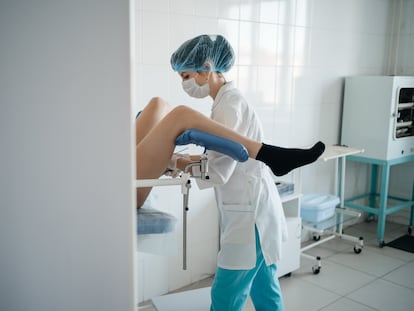A muscle-regenerating gel aims to treat pelvic floor dysfunctions
A study in rats with injuries like the ones women sustain in childbirth points to new treatments for pathologies such as genital prolapse and incontinence


In vaginal childbirth, the pelvic muscles are subjected to tremendous stretching and can suffer damage, e.g., tears. These injuries can lead to pelvic floor disorders such as pelvic organ prolapse and urinary and fecal incontinence. The most common treatment option is rehabilitation, although in acute cases surgery may be necessary. However, the damaged fibers do not recover, says Pamela Duran, a bioengineer at the University of California. She and her team have created a hydrogel based on an extracellular matrix extracted from pigs, which has succeeded in regenerating the affected tissue. The results of the research, which was conducted in rats, were recently published in the journal Science Translational Medicine.
The rats suffered injuries similar to those sustained by women in childbirth. In the research, Duran’s team induced these injuries in the animals. The author explains that hydrogel was applied to one group as soon as the damage occurred and to another group four weeks later (simulating the time to a postpartum check-up). In the first case, the scientists found that the treatment helped prevent atrophy and fibrosis in the affected muscles. In the second case, in addition to the effect achieved in the first, the researchers observed that the muscle fibers that had been damaged were regenerated, returning to pre-injury levels.
Prolapse is the descent of the pelvic organs due to the loss of tension of the ligaments that connect the genitals with the bony pelvis, explains Antonio Cano, the coordinator of the INCLIVA Foundation’s Women’s Health section. It is the most common problem. The Pelvic Floor Unit of the Obstetrics and Gynecology Service at the 12 de Octubre University Hospital in Madrid, Spain, states that 50% of women over the age of 50 “will have some degree of genital prolapse.” That is followed by urinary incontinence, which they estimate at between 8% and 50%, depending on the age range. They do not give specific data on the prevalence of fecal incontinence, but state that between 5% and 7% will suffer obstetric-related anal sphincter tears, which can lead to this problem.
Irene Díez, the president of the pelvic floor section of the Spanish Society of Gynecology and Obstetrics (SEGO), explains that it is difficult to establish the prevalence of these conditions because the relationship between cause and effect is not immediate. “These lesions occur when we are young but become evident in later stages with the passage of time and other risk factors, such as obesity and aging.” In addition, tears and other damage to these muscles are often not visible to the naked eye and can go unnoticed. For that reason, she recommends that women see a specialist after childbirth to work on strengthening their pelvic muscles.
The importance of physiotherapy
The main treatment for those suffering from these ailments is rehabilitating the musculature. Laura Arcas, a physiotherapist specializing in urogynecological dysfunctions, explains that the first step is to determine the patient’s control over these muscles and their degree of automatism (the ability to contract on their own). She adds that the state of the abdomen must also be evaluated because it works in conjunction with the pelvic floor. In physical therapy, they work on the support function (keeping the pelvic organs in place), continence and sexual function (patients may see their ability to reach orgasm impaired and feel pain during sexual intercourse).
Once she knows the patient’s condition, she begins exercises to increase muscle fiber volume. If part of this fiber has broken, it can no longer be recovered, but they try to strengthen the remaining healthy ones. “If the rest make up for the one that is broken and can perform their function well, they can compensate for the damage,” Arcas points out. In cases where these exercises alone do not help, they use other approaches, such as electrotherapy, which applies electrical currents to the muscles.
The physiotherapist warns that the damage suffered by the pelvic musculature during childbirth cannot be prevented. However, “if they maintain good habits, good hydration, do not smoke and are in good physical condition, surely dilation will be better, and the pelvic floor will be less damaged.”
She adds that the use of tools during birth, such as forceps and vacuum cups, increase the tension to which the musculature is subjected, as well as the risk of tearing. Cano concurs and notes that injuries can be reduced if the fetal head’s engagement with the birth canal takes place gradually.
If rehabilitation does not work, other treatments, including surgery, may be used. For example, Díez explains that, in the case of prolapse, devices are used that adjust to each woman’s physiognomy and keep the pelvic organs in place. If surgery is necessary, Cano says that there are two options: the prolapsed organs can be removed, or they can be attached to a higher structure.
There are also surgical options for treating incontinence, but Arcas notes that physical therapy must be done in either case. “If you don’t go work with a physical therapist, the results will be negative because the musculature is not going to recover its function.”
Irene Díez and Pamela Duran, the lead author of the study, agree on the importance of these pathologies in women’s daily lives. “Incontinence can greatly affect your quality of life because you change your behavioral habits,” says the gynecologist. The bioengineer emphasizes how stigmatized these problems are. “They often prevent many patients from participating in various activities because of the discomfort and embarrassment they feel.”
Pamela Duran, the lead author, highlights her work’s role within research on new approaches in regenerative medicine. She also says that the results obtained with the hydrogel they have developed, its low cost and the fact that it is applied in a minimally invasive manner, justify its clinical use. For the time being, the next step is to continue the research in other animal models before they can begin trials on women, which is still a long way off. Cano emphasizes that they didn’t have an option like this until now. “[The researchers] were able to make it a reality in an animal model.”
Sign up for our weekly newsletter to get more English-language news coverage from EL PAÍS USA Edition
Tu suscripción se está usando en otro dispositivo
¿Quieres añadir otro usuario a tu suscripción?
Si continúas leyendo en este dispositivo, no se podrá leer en el otro.
FlechaTu suscripción se está usando en otro dispositivo y solo puedes acceder a EL PAÍS desde un dispositivo a la vez.
Si quieres compartir tu cuenta, cambia tu suscripción a la modalidad Premium, así podrás añadir otro usuario. Cada uno accederá con su propia cuenta de email, lo que os permitirá personalizar vuestra experiencia en EL PAÍS.
¿Tienes una suscripción de empresa? Accede aquí para contratar más cuentas.
En el caso de no saber quién está usando tu cuenta, te recomendamos cambiar tu contraseña aquí.
Si decides continuar compartiendo tu cuenta, este mensaje se mostrará en tu dispositivo y en el de la otra persona que está usando tu cuenta de forma indefinida, afectando a tu experiencia de lectura. Puedes consultar aquí los términos y condiciones de la suscripción digital.
More information
Últimas noticias
Most viewed
- Reinhard Genzel, Nobel laureate in physics: ‘One-minute videos will never give you the truth’
- Oona Chaplin: ‘I told James Cameron that I was living in a treehouse and starting a permaculture project with a friend’
- Pablo Escobar’s hippos: A serious environmental problem, 40 years on
- Chevy Chase, the beloved comedian who was a monster off camera: ‘Not everyone hated him, just the people who’ve worked with him’
- Why we lost the habit of sleeping in two segments and how that changed our sense of time










































